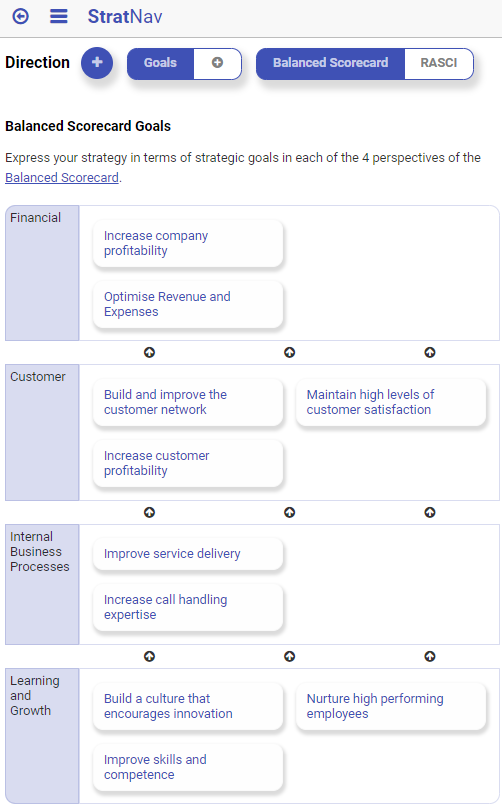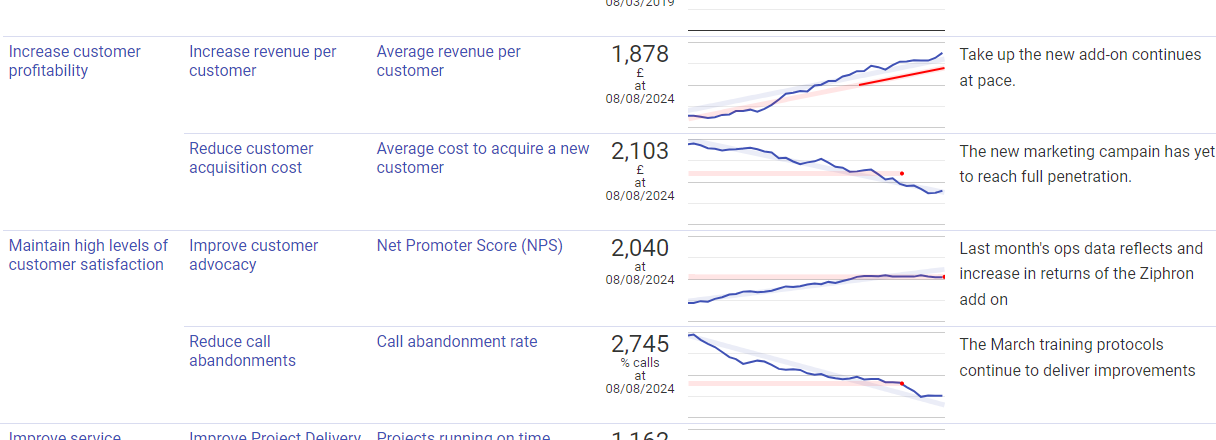 Key Takeouts
Key Takeouts
This guide provides a clear framework for strategic planning. You will learn:
- The 6 Building Blocks of Strategy: Understand the key differences and relationships between strategic goals, objectives, KPIs, targets, initiatives and actions.
- A Step-by-Step Method: Learn how to build your own strategic plan, starting from a high-level Vision or Mission Statement, and breaking it down into the 6 Components.
- How to Avoid Common Mistakes: Tips and tricks to ensure your strategies aren't amongst the many that fail.
The 6 Building Blocks of Strategy
The 6 Building Blocks of Strategy are:
- Strategic Goals: statements of long-term strategic direction.
- Objectives: short to medium term and SMART
- KPIs: Key Performance Indicators for measuring progress towards achieving those objectives.
- Targets: Specific KPI outcomes to be achieved within specific time frames.
- Initiatives: Programmes of action you will undertake to achieve your goals, objectives and targets.
- Actions: The specific actions which make up your Initiatives.
StratNav embeds and links all of these components to help you develop and execute strategies that are tangible, action-oriented, get delivered and produce results.
Let's look at each in turn.
Goals
Goals are high-level statements of direction. They should be aspirational. They should remain constant until your strategy changes.
Examples might be:
- Improve customer retention
- Target new parents
- Reduce process waste
- Maintain the dividend
- Improve member engagement
- Serve customers more quickly
- Penetrate a new market
You can see that goals typically consist of a verb and a noun.
- The verb is the thing you want to happen (e.g. improve, increase, reduce, maintain). The verb is usually one that indicates movement and direction.
- The noun is the thing you want it to happen to (e.g. customer retention, waste, dividends, member engagement).
A strategy normally consists of several interlinked goals.
- Not a list of unrelated goals.
- Goals should be mutually reinforcing.
- There should be identifiable hypotheses of cause and effect between goals.
For example, you might have a goal to serve customers more quickly because you believe that will lead to improved customer retention (which is another goal).
Your goals should be unique to your organisation. They are very much dependent on your vision and mission statement, and on your strategic analysis.
For example, if your analysis showed that:
- The cost of raw materials is increasing at twice the pace of inflation
- Customers are becoming more concerned about the impact their consumption has on the environment, and
- Robotic technology for mixing materials is becoming more affordable,
then you might decide to set a goal to reduce process waste.
 The Balanced Scorecard framework helps you to achieve mutual reinforcement and identify hypotheses of cause and effect by dividing your goals into four perspectives.
The Balanced Scorecard framework helps you to achieve mutual reinforcement and identify hypotheses of cause and effect by dividing your goals into four perspectives.
- Financial goals are about how you create value to satisfy shareholders and invest in future opportunities.
- Customer goals are about what your customers want and value.
- Internal Business Processes goals are about getting better at what you do.
- Learning and Innovation goals are about building the capabilities you will need to improve your business.
There is an implied cause-and-effect relationship between the four perspectives.
- Achieving your Learning and Innovation goals should enable you to achieve your Internal Business Process Goals.
- Achieving your Internal Business Process goals should enable you to achieve your Customer goals.
- Achieving your Customer goals should enable you to achieve your Financial goals.
How many goals should an organisation have?
- An organisation should have 2 to 5 goals in each of those four perspectives.
- This means that an organisation should have 8 to 20 goals in total.
- Hint: Aim for somewhere in the middle of that range.
In the goal description, you should aim to answer questions like:
- What, precisely, is the goal? And equally importantly, where there is any room for doubt, what does it not include?
- Why is this goal important?
- How is the goal excitin
Sign up to StratNav now to map out the goals for your existing strategy or to develop a new strategy based on a thorough analysis of your organisation and the opportunities and challenges it faces.
Objectives
Once you've defined your goals, the next step is to break them down into objectives.
Objectives are more specific than goals both in terms of their aims and in terms of their timeframes (which are usually shorter).
In contrast to your Goals, your Objectives should be SMART, that is:
- Specific - what exactly is it?
- Measurable - how will you measure it?
- Achievable - is it realistically achievable?
- Relevant - how and why is it relevant to your strategy?
- Timebound - by when will you achieve it (including milestones along the way)?
That is, at some defined point(s) in the future, you should know that you either did or did not achieve the objective. While goals allow for some ambiguity, objectives do not.
The nature of objectives also means that they will change more often than your goals - especially as you achieve your objectives and replace them with new ones which are still aligned to the original goals.
Examples might be:
- Reduce the percentage of total customers who cancel their subscription in any given month from 5% to 2% by December 2020.
- Improve the average time it takes to answer an incoming call from 1 minute to 30 seconds by December 2020.
Sometimes you will only need one objective to define a goal. But other goals are harder to pin down. For these, you might need more than one objective.
For example, if your objective is to improve member engagement, you might set goals to:
- Increase the percentage of members who visit the website each month from 40% to 50% by December 2027, and
- Increase the percentage of members who volunteer to attend a networking event each year from 10% to 30% by December 2028.
Neither of these alone exactly defines engagement. But in combination, they give an adequate approximation.

Sign up to StratNav now to ensure your strategic goals are broken out into SMART objectives using our collaborative and integrated frameworks with AI support.
KPIs and Targets
If you've defined your objectives properly (based on your goals), your Performance Indicators (KPIs) should fall naturally out of them.
A KPI is a measurable variable that you can track on a regular basis.
In the example above, the percentage of members who visit the website each month is a measurable variable. You can track and record it every month.
You can set targets for each KPI. In the example above, the target would be 50% by December 2027.
You can set different targets for the same KPI for different time periods.
- For example, you may set a target of 50% by December 2027 and 55% by December 2028.
- Wherever you have a target which is more than a year or two away, it is helpful to set interim targets to show anticipate progress.
StratNav will draw graphs showing your progress towards your goals, using your KPIs, so that you can see if your strategy is succeeding.

See also:
- Maximising Strategic Impact with Key Performance Indicators.
- Creating a Strategy Scorecard on StratNavApp.com
Sign up to StratNav now to set the KPIs and build the strategic scorecard with which you will track the progress of your strategy.
Initiatives
Strategic Initiatives describe the things that you will do to achieve your goals and objectives.
Initiatives typically have a beginning and an end. There are typically costs associated with them.
For example:
- Launch a web site.
- Open a new branch.
Like goals, initiatives are best expressed as a verb or action done to a noun or thing.
It may take many initiatives to achieve a goal. One initiative may help to achieve many goals. StratNav will help you to map out all of these relationships.
The Goal/Inititiative Matrix will help you to ensure that
- every initiative helps you to achieve one or more goals, and
- every goal has one or more initiatives to achieve it.
That way you know that you have aligned your efforts to deliver your strategy.
See also:
Sign up to StratNav now to map your key strategic initiatives against your goal to ensure all the efforts across your organisation remain aligned.
Actions
Actions are smaller, usually self-contained, units of activity. An initiative may be broken down into the actions needed to complete it.
However, StratNav also allows you to attach actions to most other artefacts within your strategy. This enables you to manage the actions required to develop your strategy as well as to execute it.
See also:
- Creating a linking actions to other elements of your strategy.
- Streamline Your Project Management with Personal Calendar and Actions
Sign up to StratNavApp.com now track all the actions required to develop and execute your strategy, making sure nothing gets forgotten or left undone.
The relationships between them
There is an implied hierarchical relationship that flows
- from broad direction to specific action
- from goals, through objectives (KPIs and Targets) and initiatives down to actions.
However, we recognise that real life can be more complex than that. So StratNavApp.com does not enforce strictly hierarchical one-to-many relationships, but instead allows for many-to-many relations. We suggest you use these sparingly to avoid over-complicating your plan.

Goals and Objectives versus Initiatives
People often get confused between Goals and Objectives on the one hand, and Initiatives on the other.
- Goals and Objectives are the outcomes you want to achieve.
- Initiatives are the Actions you will take to achieve them.
For example:
- If your goal is to "improve time taken to fill orders", your initiative might be to "build a bigger warehouse" or "implement a new logistics system".
- If your goal is to "increase cross-sales", your initiative might be to "use marketing automation with machine learning to present suitable opportunities to customers".
- If your goal is to "improve project delivery reliability", your initiative might be to "implement a new project evaluation, approval and stage-gating process".
- If your goal is to "improve sales conversions", your initiative might be to "hire another sales representative".
Using AI to map out your strategy
StratNav's inbuilt AI will help you to:
- Formulate strategic goals in each of the four quadrants of the balanced scorecard based on your vision and mission statement and strategic analysis.
- Break those goals into objectives, taking that holistic picture into account.
- Identify suitable KPIs for your objectives.
- Identify strategic initiatives to help you achieve those goals and objectives.
- Plan those strategic initiatives by suggesting the actions you need to take to complete them.
It can also help you write a vision and mission statement based on your goals and objectives, in case you want to do it the other way around.
Remember:
- The AI will only make suggestions. It's up to you to choose whether you accept, reject, or want to modify them.
- The AI will take into account all of the information in StratNav whenever it makes any suggestions, so it is worth:
- Doing a comprehensive strategic analysis before finalising your goals.
- Coming back and running the AI again as new information and decisions come to light and are captured.
Next Steps
Are you ready to start building your strategy? StratNav contains all the tools you need to build your strategy out of these 6 Building Blocks, and then to track and guide it to success. It also includes tools to help you work out what your strategy should be in the first place, and to adjust it in real time as you execute it.
Here's how to get started.
